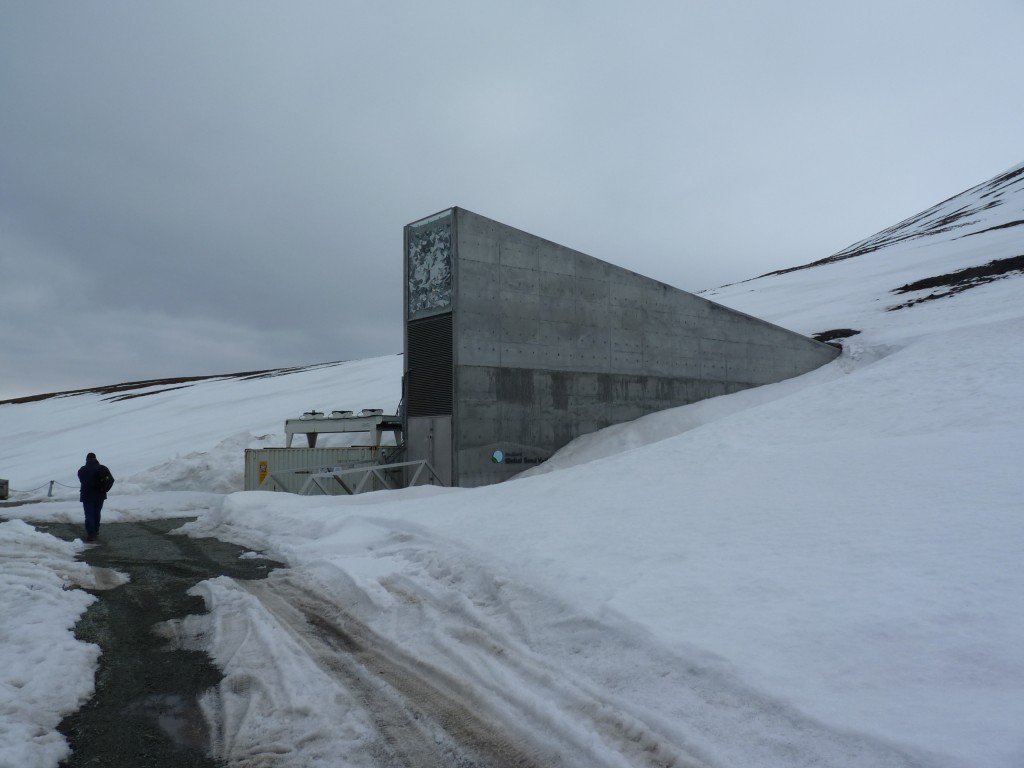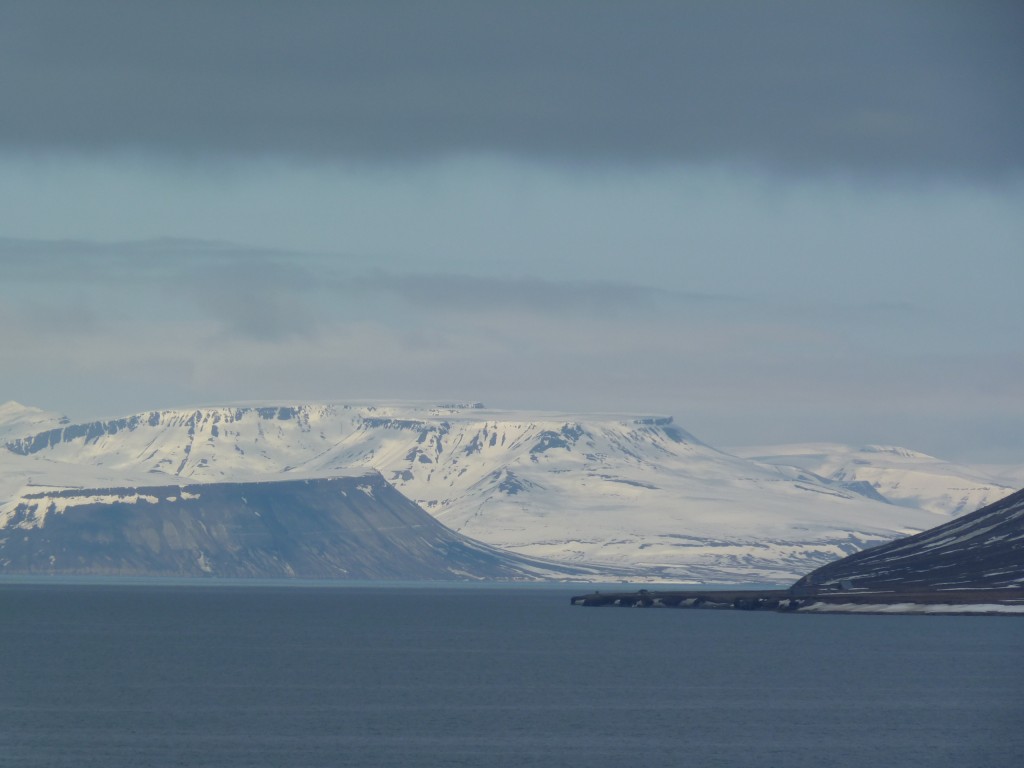Search Results for Tag: food security
Birthday gift for Svalbard Seed Vault
Far below a mountain of permafrost, the seeds are secured for future generations. Here they are safe from war, earthquakes, tsunamis and other catastrophes. The “Doomsday Vault”, as it is sometimes called, was set up on Svalbard six years ago. Some 800,000 different seed samples have since been brought north. This week marks six years of the seed vault, ten years since the Global Crop Diversity Trust (GCDT), was opened.
Farm crop diversity dwindling
“We need to conserve the diversity of the major crops, in order to be able to feed the world in the future. This diversity is really the building blocks for the future of agriculture. And agriculture is up for some major challenges,” Marie Haga, the Executive Director of GCDT, told me in an interview as she prepared to head for Svalbard for an anniversary board meeting.
“We need to feed one billion more people in the next ten years and we have to do this in the midst of climate change.”
At the same time, many species of food crop are disappearing, she explained. “Since 1900, the US has lost 90% of the diversity of its fruit and vegetables in the fields. That is dramatic.”
Haga said there are similar events being documented in European countries, including major food producing nations like Spain.
“In the 1970s, Spain had 400 varieties of melons in the fields. Today they have only 12. We we are losing diversity out there in farmers’ fields because of the way we do agriculture,” Haga said. “That’s why it is so important that we conserve these seeds in seed banks around the world.”
Haga believes that by saving seeds and preserving a diverse collection of plant genes, we will be prepared for the climate challenges of the future.
“The temperature is increasing globally. The weather is more unpredictable,” she said. “We know we will not dramatically change the way we do agriculture over the next few years. And that means we are even more dependent on these seeds that are stored in plant gene banks around the world.”
War and disaster endanger crop diversity
GCDT supports an international network of gene banks which collect seeds from their particular region. But in the event of war or natural disaster, these facilities may be vulnerable to damage.
“We know we have lost plant gene banks in the Philippines for instance, in floods and fires. Very important gene banks have been lost in Afghanistan, These days we are very concerned about what is happening to a very important seed bank in Aleppo in Syria. Something could happen to the very important diversity of wheat we have in that seed bank. ”
But the Svalbard Seed vault is considered one of the safest seed storage sites in the world. “It is in permafrost and we know that will last for a long time even though the climate is changing,” said Haga. “The seed vault is far above sea level. It is in a very stable part of the world. There are no earthquakes and it’s a politically stable area.”
As the conflict in Syria continues, the seed bank there is in danger. But the same seeds are also stored at the site in Svalbard. “So if something happens to the gene bank in Syria, we know it is possible to retrieve the material on this island in the far north.”
This week 20,000 new samples are arriving on the Arctic island to mark the seed bank’s tenth anniversary,
“For the first time we will get a substantial deposit of seeds from Japan, which is important. We know Japan has gone through terrible stresses with the tsunami and earthquakes.”
So far, the “Doomsday Vault” has never been called on to release its underground treasures – but they are ready if the need should arise.
“There are lots of uncertainties around the globe, some man-made, some by natural disasters. In case something were to go terribly wrong, we know it’s a very unique possibility to go to Svalbard and retrieve material lost out there in the real world.”
Seeds in transit: from Australia to Svalbard

Ice blog followers may remember my account of a visit to the Svalbard seed vault, which preserves a wide variety of seeds safe under the permafrost of an Arctic mountain for posterity. The story is also online at DW’s environment website.

The idea is that saving a wide diversity of crop seeds could help humankind survive in the future in spite of any disasters occurring – or, for instance, to help agriculture cope with the challenges of a changing climate.
Well the vault has just celebrated its third birthday with a bumper delivery of seeds from different parts of the world. For the first time ever, seeds have been delivered from Australia, just about as far away as you can get from the Arctic. Australia is one of the areas of the world that are particularly vulerable to climate change. It has had to cope with an increasing number of extreme weather events, droughts and floods. The seeds brought to Svalbard were the furthest travelled of the more than 600,000 samples now stored at the vault.
Most of Australia’s food crops come from outside the country, and so are dependent on global crop diversity.
There’s more information on the website of the Global Crop Diversity Trust. See also “Wild Relatives can save our food supply” on why it’s important to preserve crop seeds for posterity.
The Permafrost and Global Food Security

My first day in Spitsbergen brought a very special highlight. I was fortunate enough to come on a day that coincides with a visit by Professor Roland von Bothmer from the Swedish University of Agricultural Sciences, who also looks after public relations for the SVALBARD SEED VAULT.

You may vaguely remember hearing about this when it was set up in 2008, with the aim of storing samples of food seeds from all over the globe under super-safe conditions, deep under the permafrost of Svalbard.

You may also have heard of some damage to the entrance to the vault because of permafrost melting. Was climate change already threatening the very facility that should help ensure food security no matter what changes – climatic or otherwise – endanger the planet?
No way, says Prof. von Bothmer. The damage to the entrance to the tunnel which leads down to the subterranean vault has no effect on the operation of the vault itself, he says, and the reason for building this facility this far north and under this permafrost, is still valid. It’s thought to be one of the safest places on the planet, even in a rapidly warming world.

Access to the vault is very strictly controlled.

Human warmth affects the temperature inside. So there are only a few visits a year, often with visiting heads of state or the UN, as with the case last year. And very occasionally, a visiting journalist.
Professor von Bothmer is a man who loves his work and is dedicated to it. He has collected seed samples all over the world himself and considers himself very lucky to be involved in the Svalbard Seed Vault project, in a way the highlight of his professional activities to date. The idea of protecting crop diversity in a world where for one reason or another species are dying at an alarming rate, is one that inspires him.
The tunnel entrance is high above Svalbard airport. It’s cold outside today, but he warned me it would be much colder where we were going. We went into the entrance tunnel, where workmen are carrying out some maintenance and repair work. Then we went into the warmer “master control room” – well, the computer room – and changed into thermal suits.

They look hilarious, but I wouldn\’t like to go down into the vault without one.Minus 18 C. is thought to be the ideal temperature for storing seed material. So it was pretty “nippy” when we finally got into the main chamber, which has a complex cooling system in addition to the natural permafrost.
You go through a system of “air locks” to reduce any warm temperature impact from your body on the vault itself. It is still being extended into the hillside to increase capacity.

Seed samples are sent in from gene banks around the globe – we saw samples of Danish barley and some seeds from India, vacuum packed, ready for storage – for who knows how many hundred years?

The climate change crisis has given the vault increased relevance, even over the past two years, says the Professor. Even with “winners and losers”, areas being hit by drought, flooding, warmth, cold, new or changing pests and diseases, will need a diversity of crop types to cope. So this remote, icy area with its dearth of arable land and crops of its own, could provide the back-up seeds to feed the world of the future.
Svalbard Seed Vault
Climate Change threatening Arctic Seed Vault
I heard one piece of news this week which shocked me – and it worries me that it didn’t make its way into most of the media.
Earlier this year, the Global Seed Vault was opened on the Norwegian Arctic island of Spitsbergen. The idea is to store seeds of all the earth’s important plants, so that if we should experience any kind of major catastrophe, from nuclear explosions to mass epidemics or – yes – climate change, there could be a new start with the seeds from this bunker. It’s built into a hill, supposedly covered with permafrost.The seeds have to be kept between minus 18 and minus 20 degrees C.
But the vault hasn’t even survived one polar summer, with temperatures on the rise. The permafrost has partially thawed and the entrance tunnel to the vault has been damaged.
The Global Seed Vault management seem to be playing this down and say they’ll just have to use the bunker’s cooling system more often. But surely, that’s not quite the point?
Story and pictures on Spiegel Online
And here’s the link to the Global Seed Vault project:
All about the Spitsbergen bunker:


















Feedback